Overview
- Brief Narrative
- Postwar print of a street scene drawn by Bedrich Fritta while a prisoner in Theresienstadt ghetto-labor camp. Fritta, a Czech Jewish cartoonist and graphic designer, was deported to the camp from Prague on November 24, 1941. He was assigned to head the Graphic Department. Fritta was part of a tight knit group of artists determined to secretly document the wretched conditions of daily life in the camp. In summer 1944, they were accused by the Gestapo of smuggling their 'gruesome', atrocity propaganda, that is realistic, work out of the camp. Fritta, his wife Hansi, and son Tomas, 3, were sent to prison. Fritta was tortured. His wife died of starvation or typhus. On October 26, Fritta, with artist Leo Haas, was deported to Auschwitz, where he died, age 37, on November 9, 1944. His son Tomas survived and was adopted by Leo Haas. Nearly 200 of Fritta's drawings were hidden and preserved by other inmates.
- Date
-
issue:
1950-1960
- Credit Line
- United States Holocaust Memorial Museum Collection, Gift of Charlotte Schiff
- Contributor
-
Artist:
Bedrich Fritta
- Biography
-
Fritz Taussig (later Bedrich Fritta) was born on September 19, 1906, in Visnová u Frydlantu, Bohemia, Austro-Hungary, (now Visnova, Czech Republic). He went to Paris to study art and upon his return, settled in Prague. He worked as a cartoonist and graphic designer, primarily creating advertising and publicity materials. His career advanced and Fritta became well known for his paintings and drawings, as well as his commercial work. In the 1930s, he created anti-Fascist political caricatures and was an illustrator for the magazine Simplicissimus. In September 1938, at a conference in Munich, Germany, the western powers agreed to Hitler’s annexation of the Sudetenland in Czechoslovakia. The Czech government was not a participant at the conference. On March 1939, Germany annexed the Bohemia, and Moravia provinces, where Prague was located. German allies took over other regions, and Czechoslovakia ceased to exist.
The provinces were governed by a Reich Protector. Jews were banned from Czech society. They were barred from most professions and could not run businesses or participate in organizations. In September 1939, Germany invaded neighboring Poland. In September 1941, Jews in Prague were required to wear Star of David badges to mark them as outcasts. That month, Reinhard Heydrich, the SS head of RSHA, Reich Main Security Office, was made Reich Protector. As part of his preparations to permanently solve the Jewish problem, he ordered the establishment of a prison complex, Theresienstadt, the German name for Terezin, about 40 miles north of Prague.
Bedrich, his wife Johanna (Hansi), and their two year old son Tomas were deported to Theresienstadt with the second Aufbaukommando, [construction commando], Transport J. No. 482, on December 4, 1941. He was part of a group of engineers, artists, doctors, and others needed to set up and organize the ghetto. Fritta was assigned to the technical department of the Jewish Council that governed the camp for the Germans. They documented the construction of the camp and its conversion from a fortress to a prison camp. Fritta was made head of the Graphic department, which created reports, maps, construction plans, propaganda, and other materials required by the SS. As head of the drafting room, he recruited and offered jobs to other artists. This position gave Fritta and the others access to drawing materials and paper. Fritta was a member of a group of artists who secretly made drawings of the inmates and the daily life of Theresienstadt camp in order to document the misery and deplorable conditions in which they lived. During this time, he also created a birthday book for his young son Tomas filled with humorous pictures celebrating life as it was before the ghetto - and hopefully as it would be after.
The Germans used Theresienstadt as a show ghetto for visitors from the outside world, such as the International Red Cross. They would arrange tours with staged events of camp life to show as an example of normal conditions in a Jewish settlement. In summer 1944, works by Fritta and the other artists, showing the real conditions in camp that had been smuggled out of camp, were discovered by the Germans. On July 17, 1944, Fritta and several others, including Leo Haas, Otto Ungar, and Ferdinand Bloch, were arrested for creating and distributing these realistic pictorial testimonies which the Germans called atrocity propaganda. The accused in the Painter's Affair were interrogated by Adolf Eichmann and others, but no one in the group supplied information. Bedrich, his wife, Hansi, and three-year-old son, Tomas, the Nazi's youngest political prisoner, were sent to the camp's Small Fortress prison. Bedrich was tortured and assigned to hard labor. Hansi soon died, of starvation or typhus. On October 26, Bedrich and Leo Haas, and their families, were deported to Auschwitz concentration camp. Bedrich, 37, died a week later of exhaustion and blood poisoning, on November 8, 1944. His son Tomas (1941-2015) survived the war, which ended with Germany’s surrender on May 7, 1945. Tomas was adopted by Leo Haas and his wife Erna. Nearly two hundred of Fritta’s drawings had been hidden and preserved by other inmates, and many items, including Tomas' birthday book, were recovered by Haas after the war.
Physical Details
- Language
- German
- Classification
-
Art
- Category
-
Prints
- Object Type
-
Cityscapes (lcsh)
- Physical Description
- Black and white print of a street scene with buildings.
- Dimensions
- overall: Height: 10.375 inches (26.353 cm) | Width: 7.500 inches (19.05 cm)
- Materials
- overall : paper, ink
Rights & Restrictions
- Conditions on Access
- No restrictions on access
- Conditions on Use
- No restrictions on use
Keywords & Subjects
Administrative Notes
- Legal Status
- Permanent Collection
- Provenance
- The print was given to Herman Goldschmidt in Frankfurt am Main, Germany, and was donated to the United States Holocaust Memorial Museum in 2000 by Charlotte Schiff.
- Record last modified:
- 2023-06-06 08:28:07
- This page:
- https://collections.ushmm.org/search/catalog/irn515133
Also in Charlotte Schiff collection
Collection of armbands, Star of David badge, documents, scrip, and a drawing relating to Charlotte Schiff's (Charlotte Goldschmidt) experiences during the Holocaust in Terezin (Theresienstadt) and her registration as a displaced person.
Date: 1943-1946

Armband from Terezin ghetto-labor camp
Object
Armband, white fabric with two rows of dark stitching, "K.L." written in blue ink inside triangle, "Terezin" written beneath triangle, two circular ink stamps (one of either side of triangle, reading "Zamosprava Byv. Gheta Terezina" with image of snake wrapped around pole in center).
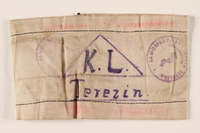
Armband from Terezin ghetto-labor camp
Object
Armband, white fabric with two rows of dark stitching, "K.L." written in blue ink inside triangle, "Terezin" written beneath triangle, two circular ink stamps (one of either side of triangle, reading "Zamosprava Byv. Gheta Terezina" with image of snake wrapped around pole in center).

Theresienstadt ghetto-labor camp scrip, 1 krone note
Object
Scrip, valued at 1 krone, issued in the Theresienstadt (Terezin) ghetto-labor camp in 1943. All currency was confiscated from deportees upon entry and replaced with scrip and ration coupons that could be exchanged only in the camp. The Theresienstadt camp existed for 3.5 years, from November 24, 1941 to May 9, 1945. It was located in a region of Czechoslovakia occupied by Germany, renamed the Protectorate of Bohemia and Moravia, and made part of the Greater German Reich.

Theresienstadt ghetto-labor camp scrip, 1 krone note
Object
Scrip, valued at 1 krone, issued in the Theresienstadt (Terezin) ghetto-labor camp in 1943. All currency was confiscated from deportees upon entry and replaced with scrip and ration coupons that could be exchanged only in the camp. The Theresienstadt camp existed for 3.5 years, from November 24, 1941 to May 9, 1945. It was located in a region of Czechoslovakia occupied by Germany, renamed the Protectorate of Bohemia and Moravia, and made part of the Greater German Reich.
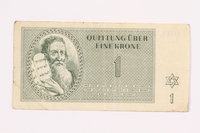
Theresienstadt ghetto-labor camp scrip, 1 krone note
Object
Scrip, valued at 1 krone, issued in the Theresienstadt (Terezin) ghetto-labor camp in 1943. All currency was confiscated from deportees upon entry and replaced with scrip and ration coupons that could be exchanged only in the camp. The Theresienstadt camp existed for 3.5 years, from November 24, 1941 to May 9, 1945. It was located in a region of Czechoslovakia occupied by Germany, renamed the Protectorate of Bohemia and Moravia, and made part of the Greater German Reich.

Theresienstadt ghetto-labor camp scrip, 2 kronen note
Object
Scrip, valued at 2 kronen, issued in the Theresienstadt (Terezin) ghetto-labor camp in 1943. All currency was confiscated from deportees upon entry and replaced with scrip and ration coupons that could be exchanged only in the camp. The Theresienstadt camp existed for 3.5 years, from November 24, 1941 to May 9, 1945. It was located in a region of Czechoslovakia occupied by Germany, renamed the Protectorate of Bohemia and Moravia, and made part of the Greater German Reich.
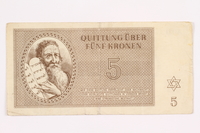
Theresienstadt ghetto-labor camp scrip, 5 kronen note
Object
Scrip, valued at 5 kronen, issued in the Theresienstadt (Terezin) ghetto-labor camp in 1943. All currency was confiscated from deportees upon entry and replaced with scrip and ration coupons that could be exchanged only in the camp. The Theresienstadt camp existed for 3.5 years, from November 24, 1941 to May 9, 1945. It was located in a region of Czechoslovakia occupied by Germany, renamed the Protectorate of Bohemia and Moravia, and made part of the Greater German Reich.
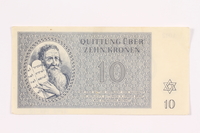
Theresienstadt ghetto-labor camp scrip, 10 kronen note
Object
Scrip, valued at 10 kronen, issued in the Theresienstadt (Terezin) ghetto-labor camp in 1943. All currency was confiscated from deportees upon entry and replaced with scrip and ration coupons that could be exchanged only in the camp. The Theresienstadt camp existed for 3.5 years, from November 24, 1941 to May 9, 1945. It was located in a region of Czechoslovakia occupied by Germany, renamed the Protectorate of Bohemia and Moravia, and made part of the Greater German Reich.
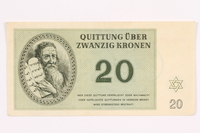
Theresienstadt ghetto-labor camp scrip, 20 kronen note
Object
Scrip, valued at 20 kronen, issued in the Theresienstadt (Terezin) ghetto-labor camp in 1943. All currency was confiscated from deportees upon entry and replaced with scrip and ration coupons that could be exchanged only in the camp. The Theresienstadt camp existed for 3.5 years, from November 24, 1941 to May 9, 1945. It was located in a region of Czechoslovakia occupied by Germany, renamed the Protectorate of Bohemia and Moravia, and made part of the Greater German Reich.

Theresienstadt ghetto-labor camp scrip, 50 kronen note
Object
Scrip, valued at 50 kronen, issued in the Theresienstadt (Terezin) ghetto-labor camp in 1943. All currency was confiscated from deportees upon entry and replaced with scrip and ration coupons that could be exchanged only in the camp. The Theresienstadt camp existed for 3.5 years, from November 24, 1941 to May 9, 1945. It was located in a region of Czechoslovakia occupied by Germany, renamed the Protectorate of Bohemia and Moravia, and made part of the Greater German Reich.
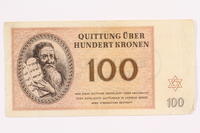
Theresienstadt ghetto-labor camp scrip, 100 kronen note
Object
Scrip, valued at 100 kronen, issued in the Theresienstadt (Terezin) ghetto-labor camp in 1943. All currency was confiscated from deportees upon entry and replaced with scrip and ration coupons that could be exchanged only in the camp. The Theresienstadt camp existed for 3.5 years, from November 24, 1941 to May 9, 1945. It was located in a region of Czechoslovakia occupied by Germany, renamed the Protectorate of Bohemia and Moravia, and made part of the Greater German Reich.
Charlotte Schiff papers
Document
Documents relating to Charlotte Schiff's (Charlotte Goldschmidt) [donor] experiences during the Holocaust. The documents include identification card, "Sonderausweis," issued to Charlotte Goldschmidt (donor) who had been imprisoned in Theresiendtadt concentration camp; issued July 26, 1946; Frankfurt, Germany. Indentifiaction card, "United Nations Displaced Person/Refugee Identification card," issued to Charlotte Goldschmidt. Identification card, Sonderausweis, for Irma Goldschmidt, donor's mother issued July 26, 1946. Registration card from the Czechoslovak Repatriation Office for Charlotte, isssued July 1, 1945.




